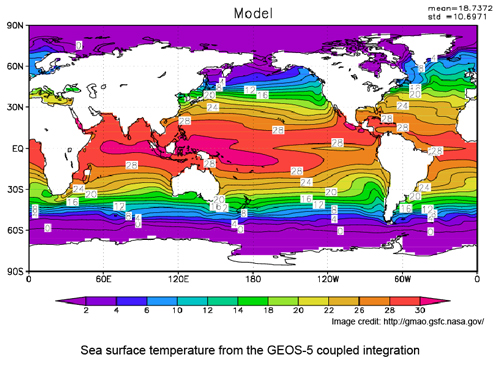Air-Sea Interactions in the GEOS Model
In order to understand how the climate responds to variations in forcing, one necessary component is to understand the full distribution of variability of exchanges of heat and moisture between the atmosphere and ocean. A number of studies recognize the important role of surface heat and moisture fluxes in the generation and decay of important coupled air-sea phenomena. These mechanisms operate across a number of scales and contain significant contributions from interactions between the anomalous (i.e. non-mean), often extreme-valued, flux components. It is important to have a characterization and understanding of these processes for the development of accurate modeling efforts.
We are evaluating how the distributions of the fluxes vary in space and time between our observational data, NASA’s Global Modeling and Assimilation Office Project’s GEOS-5, and GEOS-6 models datasets, their representation in different weather-regimes, and how these variations affect the climatology. We will be evaluating how the models differ with differing weather and climate states, and explore the driving oceanic and atmospheric factors producing the distributions. Emphasis will be placed on the representation of near-surface forcing variables directly related to their estimation, and understanding the distribution of the fluxes including extremes. The extent to which the model simulations of the surface fluxes rectify onto sea surface temperature on seasonal to interannual time scales will be quantified. The proposed inclusion of diurnal sea surface temperature warming, wave effects, and surface roughness changes in GEOS-6 establishes a need to characterize their impacts to the representation of turbulent surface heat and moisture fluxes.
We are working with a unified approach to evaluate the representation of the turbulent fluxes at the air-sea interface in the current and evolving Goddard Earth Observing System (GEOS) model. This research addresses the task of using observations to identify and characterize model uncertainties in key aspects of the air-sea coupling on synoptic to interannual time scales. The anticipated results of this research will be three-fold:
- Better understanding of the distribution of surface fluxes across the global oceans
- Key feedbacks and regimes that need further improvements in the models
- An analysis of improved air-sea flux parameterizations and boundary models and their effects in GEOS-5 and GEOS-6 models.

Funding Agencies
The National Aeronautics and Space Administration funded this research.

Partners/Collaborators
This is a joint project with the NASA Marshall Space Flight Center.